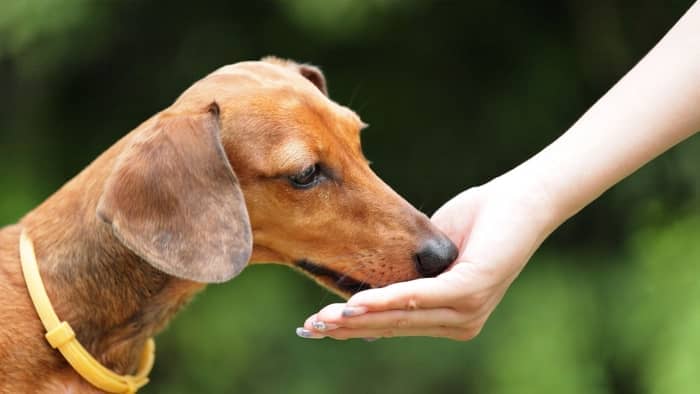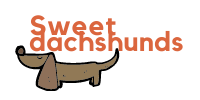Feeding puppies and smaller dogs can feel complicated due to their tiny size. So, here’s our miniature dachshund feeding chart, info, and tips. Of course, you should always remember to talk with your vet before going off on articles on the internet. And, when in doubt, following the amounts recommended by the food’s manufacturer is strongly advisable. However, if you’re looking for a good miniature dachshund feeding guide to help you get an idea as to what you’re in for, we’ll do the best we can below.
Miniature Dachshund Feeding Chart
No feeding chart can ever be 100% exact. Every puppy is different even in the case of such a tiny breed. A difference of half a pound may seem minuscule but it matters greatly, especially while the puppy is still growing. The difference in activity levels is also crucial. Extra playful puppies will naturally need more food. Whereas more inactive and chill dogs should be overfed or they will get overweight.
In fact, even with a still-growing puppy overfeeding can be a problem due to the increased risk of developing bone issues. Fortunately, mini Doxies don’t seem predisposed to overeating even when given the chance.
So, while following the food instructions on the package as well as your vet’s personalized instructions is always recommended, here’s a general miniature dachshund feeding chart to give you an idea as to how to feed your pup.
| Puppy age | Puppy weight | The daily amount of food | Number of meals per day | Amount per meal |
| 2 months | Less than 2.2 lbs (or 1 kg) | Between 2 and 2.5 ounces (or 67 grams) | 4 | 1/2 ounces (about 17 grams) |
| 3 months | About 2.2 lbs (or 1 kg) | Between 2.5 and 3 ounces (or 75 to 85 grams) | 4 | A bit over 1/2 ounces (about 20 grams) |
| 5 months | About 4.5 lbs (or 2 kg) | Between 3 and 4 ounces (80 to 100 grams) | 3 | About 1 ounce (25 to 35 grams) |
| 7 months | About 6.5 lbs (or 3 kg) | Between 5 and 5.5 ounces (about 150 grams) | 2 | 6 to 8 ounces (75 grams) |
| 9 months | About 8.5 to 9 lbs (or 4 kg) | About 7 ounces (200 grams) | 2 | 6 to 8 ounces (100 grams) |
| 11 months and above | 9 to 10 lbs (or 4 to 4.5 kg) | 8 to 9 ounces (about 250 grams) | 2 | 4 to 4.5 ounces (125 grams) |
Are There Health Risks Of Overfeeding Or Underfeeding Your Dog If You’re Not Following The Miniature Dachshund Feeding Chart?
Aside from the aforementioned risk of developing bone problems, overfeeding a puppy can also lead to stuff such as diarrhea and vomiting. Bloating (Gastric Dilatation Volvulus) is also a possible concern as is obesity. Just because a puppy is still growing, don’t make the mistake of thinking that it can’t get overweight.
Underfeeding a puppy is also a fairly clear problem. Malnourishment can lead to a whole host of potential health issues that we won’t have the time to get into here. Suffice it to say that a growing puppy should never be left underfed. It’s not going to actually stunt the pup’s growth but it’s far from acceptable for its overall health. An adult can survive for a while with mild malnourishment but it’s still very ill-advised.
What’s The Best Dog Food For A Miniature Dachshund?
We’ll refrain from giving specific brand recommendations here, particularly since we’ve already done so in this article. The best dog food for a miniature dachshund is more or less the same as the recommended foods for other toy dog breeds. It should be of a high enough quality, it should be devoid of any artificial fillers, preservatives, and grain, and it shouldn’t have any allergens if your Doxie happens to be allergic to certain foods.

Aside from that, as long as the food is good and with high nutritional value, everything should be all right. There are certain dachshund-specific foods for adult and senior dogs, of course. Those exist mostly to help support the dachshund’s back with extra calcium and phosphorus to help prevent Intervertebral Disc Disease (IVDD).
So, How Strictly Should You Follow A Miniature Dachshund Feeding Chart?
It’s strongly recommended that you follow the exact food quantity recommendations from the miniature dachshund feeding chart. Or, even better, the recommendations on your dog’s food and your vet’s instructions. Getting the quantities right is fairly easy, especially since mini Doxies don’t need all that much food. However, there are risks to both overfeeding and underfeeding your pup so you do want to get it right.
Learn more about: What Is The Lifespan Of A Miniature Dachshund?
FAQs
[rank_math_rich_snippet id=”s-7bf97980-2c9d-45df-bc96-e73201b0859a”]




